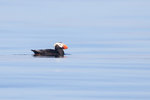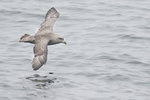

This week we conclude our 3-part series on pelagic birds, commonly called seabirds. Liam Hutcheson is again my co-author.
There is a family of seabirds in coastal, and offshore Washington waters called Alcidae or Alcids. These are small, plump fish-eating birds, and the family includes one that you will be familiar with – the puffin. These mainly black and white birds are sometimes called the “penguins of the north.” They are great swimmers and divers and can appear to fly underwater in pursuit of fish. In contrast with penguins, they are good airborne flyers as well.
The most common puffin in Washington is the Tufted Puffin. It’s a 14-inch bird, mostly black, with a dramatically large orange-red bill and, in breeding season, dramatic white plumes sweeping back from its white face patch. When you see one, you know immediately what it is.
In the 1970’s, the Tufted Puffin was a very common Washington breeding bird with 44 known breeding sites on islands along the coast and Strait of Juan de Fuca. But then, for unknown reasons, the population suffered a massive decline, with counts falling from 23,300 in 1978 to 2,958 in 2009. Puffins are now only found in 19 of the historic breeding locations. Fortunately, they are still seen fairly regularly offshore. (The Horned Puffin, a breeding bird in the northern Pacific Ocean area, also occasionally is found in Washington).
The second type of alcid commonly found in Washington is Cassin’s Auklet. These are strictly pelagic birds, and almost never seen from shore. It is a tiny (9 inches) gray bird that nests in burrows on offshore islands. It flies far out to sea for feeding. Although seldom seen, it is the most successful pelagic breeding bird in our state, with a total population estimated to be around 88,000.
The third alcid is one of Liam’s favorite birds of all time, the Marbled Murrelet. This 9-10 inch tiny bird is now found almost exclusively in marine waters along the North American West Coast. Unlike the two previous seabirds that nest in burrows on islands, this one nests on large side branches in old-growth forests, laying a single egg on the accumulated moss on the branches. They can nest up to 50 miles inland to find a suitable nesting location and thus sometimes must fly long distances from their offshore foraging ground to inland nest sites. These birds are generally found close to shore, seldom further out than three miles.
The Marbled Murrelet has suffered a very significant population decline in its range and is listed under the Endangered Species Act. Because of its breeding connection with old-growth forests, this listing has generated a lot of controversy. In 2015 the Washington population estimate was around 7500, the majority of which are found in Northern Puget Sound and the Strait of Juan De Fuca. In past years it bred in small numbers in Southern Puget Sound and may occasionally still be seen here, holding out hope for a continuation of this fragile breeding population.
There is one final pelagic bird to mention, the Norther Fulmar. This bird is related to the shearwaters that we discussed in previous columns and in Washington, it is found in good numbers far offshore along the edge of the continental shelf. It breeds on cliffs in the far Arctic and in winter is spread widely across the northern Pacific Ocean. In size and coloration, it can resemble a gull, but its soaring flight is very different, as is its tubenose bill.
Last week one reader asked why these pelagic birds are only found far offshore. The edge of North America is really the edge of the continental shelf, located in Washington about 100 miles out to sea. At that location, cold and nutrient-rich deep ocean currents meet that shelf, resulting in a natural phenomenon called upwelling – bringing this nutrient-laden water toward the surface where it meets and feeds all sorts of small marine lifeforms. These, in turn, feed an abundant food chain that includes fish and pelagic fish-eating birds (and a fish and shrimp-harvesting commercial fishing fleet).
Journeying to the feeding grounds can involve a trip of 100 miles in each direction. However, off Grays Harbor and at several other locations there are underwater canyons that bring the upwelling, and feeding, much closer to shore (more like 40 miles). These canyons were carved by the huge rivers that arose from the lobe ends of the continental glaciers and eroded canyons into the shelf when it was exposed during the ice ages.
George Walter is environmental program manager at the Nisqually Indian Tribe’s natural resources department; he also has a 40+ year interest in bird watching. He may be reached at george@theJOLTnews.com
Photos for this column are provided by Liam Hutcheson, a 15-year-old Olympia area birder and avid photographer. He is also the co-author of this column.
1 comment on this item Please log in to comment by clicking here
Bluerat
A great series on pelagic birds —lots to learn. The photographs are very fine - top notch. Thank you!
Thursday, October 13, 2022 Report this